| Malus pumila 'Aia Ilu' | |
|---|---|
| Species | Malus pumila |
| Hybrid parentage | Antonovka x ? [1] |
| Cultivar | 'Aia Ilu' |
| Origin | |
Aia Ilu (in English, Garden Beauty [2] ) is a cultivar of domesticated apple, from Estonia, first developed in 1946 by Aleksander Siimon. [1]
| Malus pumila 'Aia Ilu' | |
|---|---|
| Species | Malus pumila |
| Hybrid parentage | Antonovka x ? [1] |
| Cultivar | 'Aia Ilu' |
| Origin | |
Aia Ilu (in English, Garden Beauty [2] ) is a cultivar of domesticated apple, from Estonia, first developed in 1946 by Aleksander Siimon. [1]
The Aia Ilu has large apples, weighing from 250 to 300 grams. It is juicy, bittersweet, and has a weak aroma. [1] The Aia Ilu is grown in nurseries, but is not widely propagated. [3]
The Aia Ilu has low scab resistance [4] and is resistant to powdery mildew. [5]
There are a number of lines of defence against pests and diseases in the orchard, principal among these being the practice of good husbandry, creating healthy soil and ensuring high standards of garden hygiene. But no matter how diverse and healthy the garden eco-system may be, there will always be a degree of disease and pest presence. In many ways, some level of pathogen population in the garden can be not only acceptable but desirable as they are indicative of a generally healthful and diverse environment, and add to the overall robustness of the system as an immunity to such detrimental influences will build up, particularly in a balanced polycultural regime. Indeed, most of the plants we grow will tend to be selected because they are trouble free, and those that are more susceptible to attack will have fallen by the wayside over time. However, most farmers find it unacceptable that the food crops they grow are damaged by pests.
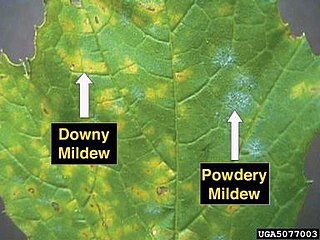
Powdery mildew is a fungal disease that affects a wide range of plants. Powdery mildew diseases are caused by many different species of fungi in the order Erysiphales. Powdery mildew is one of the easier plant diseases to identify, as its symptoms are quite distinctive. Infected plants display white powdery spots on the leaves and stems. The lower leaves are the most affected, but the mildew can appear on any above-ground part of the plant. As the disease progresses, the spots get larger and denser as large numbers of asexual spores are formed, and the mildew may spread up and down the length of the plant.

Jonagold is a cultivar of apple which was developed in 1953 in New York State Agricultural Experiment Station of Cornell University's College of Agriculture and Life Sciences, a cross between the crisp Golden Delicious and the blush-crimson Jonathan; the name Jonagold is a portmanteau of these two variety names. They form a large sweet fruit with a thin skin. Because of their large size they are now favoured by commercial growers in many parts of the world. Jonagold is triploid, with sterile pollen, and as such, requires a second type of apple for pollen and is incapable of pollenizing other cultivars. The Jonagored Apple, a sport mutation of Jonagold, was once covered under United States Patent PP05937, now expired.

Uncinula necator is a fungus that causes powdery mildew of grape. It is a common pathogen of Vitis species, including the wine grape, Vitis vinifera. The fungus is believed to have originated in North America. European varieties of Vitis vinifera are more or less susceptible to this fungus. Uncinula necator infects all green tissue on the grapevine, including leaves and young berries. It can cause crop loss and poor wine quality if untreated. The sexual stage of this pathogen requires free moisture to release ascospores from its cleistothecia in the spring. However, free moisture is not needed for secondary spread via conidia; high atmospheric humidity is sufficient. Its anamorph is called Oidium tuckeri.
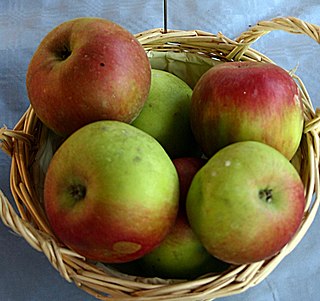
Idared is a type of apple cultivar from Moscow, Idaho, United States. Variety is characterized by a non-uniform skin color.

Antonovka, Антоновка, or Antonówka is a group of late-fall or early-winter apple cultivars with a strong acid flavor that have been popular in Russia as well as in Poland and Belarus. The most popular Russian variety is Common Antonovka, from which other cultivars derive. It was developed by pioneer Russian naturalist and plant breeder Ivan V. Michurin at his experimental orchard in the Tambov Oblast and introduced in 1888. Antonovka is famous for its unsurpassed strong and pleasant fruit aroma.
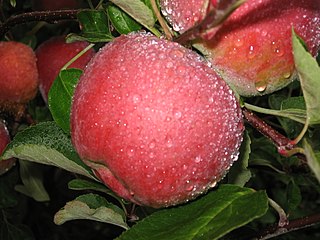
'Macoun' apples are a cross between the 'McIntosh' and 'Jersey Black' cultivars. The Macoun was developed at the New York State Agricultural Experiment Station in Geneva, by Richard Wellington. It was first introduced in 1923, and is an eating apple. This apple is excellent for making European style apple pies because it doesn't break down during cooking and remains firm. Macouns are also very popular at roadside stands and pick-your-own farms. Availability is generally October through November. Sugar 13%, acid 6g/litre, vitamin C 4mg/100g.

The Elstar apple is an apple cultivar that was first developed in the Netherlands in Elst in the 1950s by crossing Golden Delicious and Ingrid Marie apples. It quickly became popular, especially in Europe and was first introduced to America in 1972. It remains popular in Continental Europe, but less so in the United Kingdom.

Empire is the name of a clonally propagated cultivar of apple derived from a seed grown in 1945 by Lester C. Anderson, a Cornell University fruit nutritionist who conducted open pollination research on his various orchards. In 1945, under the direction of A. J. Heinicke, scientists from the New York State Agricultural Experiment Station of Cornell University in Geneva, New York, harvested the Empire seed together with thousands of its siblings. The Geneva teams grew and tested ever dwindling sub-populations of the sibling group until 1966, when the final selection, the Empire, was released to the public at the New York Fruit Testing Association meetings in Geneva. According to the US Apple Association website it is one of the fifteen most popular apple cultivars in the United States.

The 'Spartan' is an apple cultivar developed by Dr. R. C Palmer and introduced in 1936 from the Federal Agriculture Research Station in Summerland, British Columbia, now known as the Pacific Agri-Food Research Centre - Summerland. The 'Spartan' is notable for being the first new breed of apple produced from a formal scientific breeding program. The apple was supposed to be a cross between two North American cultivars, the 'McIntosh' and the 'Newtown Pippin', but recently, genetic analysis showed the 'Newtown Pippin' was not one of the parents and its identity remains a mystery. The 'Spartan' apple is considered a good all-purpose apple. The apple is of medium size and has a bright-red blush, but can have background patches of greens and yellows.

Malus floribunda, common name Japanese flowering crabapple, Japanese crab, purple chokeberry, or showy crabapple, originates from Japan and East Asia. It may be a hybrid of M. sieboldii with M. baccata, in which case it would be written as Malus × floribunda.

Podosphaera pannosa is a plant pathogen. It produces a powdery mildew on members of the rose family.
This article summarizes different crops, what common fungal problems they have, and how fungicide should be used in order to mitigate damage and crop loss. This page also covers how specific fungal infections affect crops present in the United States.

Liberty is a hybrid apple cultivar developed by the New York State Agricultural Experiment Station. It was a seedling produced in 1955 from pollinating 'Macoun' from 'Purdue 54-12' for the sake of acquiring Malus floribunda disease resistances. It was first released to the public in 1978.

Lord Lambourne is an apple cultivar with a sweet sharp flavor. It was raised by Laxtons Brothers Ltd in 1907 in Bedford, England. Received a Royal Horticultural Society Award of Merit in 1923.

Rajka is a hybrid cultivar of domesticated apple from the Czech Republic, specifically for eating. Rajka was crossed and developed by the Institute of Experimental Botany from the Champion and Katka apples for scab resistance, hence possible to grow organic.

Pristine apple is a hybrid cultivar of 'Co Op 10' x 'Camuzat' domesticated apples, which are descendants of the 'McIntosh' apple and the 'Starking Delicious'. This cultivar was developed and patented in the United States by the PRI disease resistant apple breeding program, in Indiana, United States in 1994, for its resistance to apple scab. It is susceptible to cedar-apple rust.
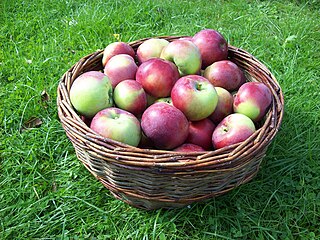
'Birgit Bonnier' is a modern cultivar of domesticated apple which have some resistance to apple scab and mildew.
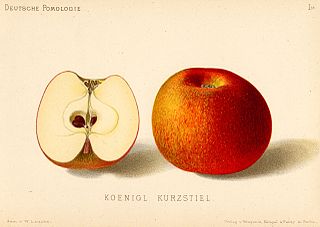
Court Pendu Plat is an extremely old French cultivar of domesticated apple that was first recorded in 1613. The cultivar definitely dates back to earlier than the 17th century, and was probably cultivated by the Romans. It is known for its intense flavor which mellows with storage.
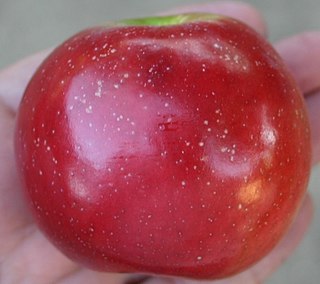
Enterprise is a modern bred, late-ripening and attractive, red cultivar of domesticated apple with excellent fruit quality combined with disease resistance to scab, cedar apple rust, fire blight and some resistance to powdery mildew. The fruit is large and attractive and retains excellent fresh quality for up to six months at 1°C. Its moderate acidity at time of harvest mellows in storage, and it is best after one month of storage.